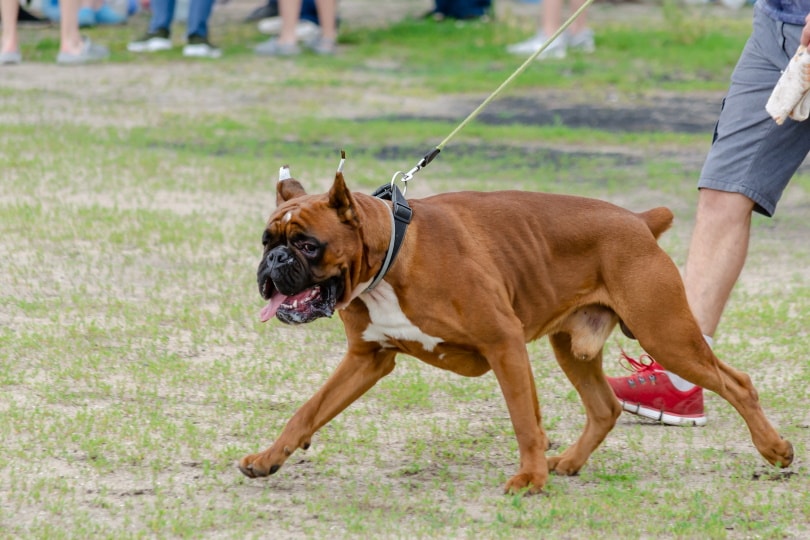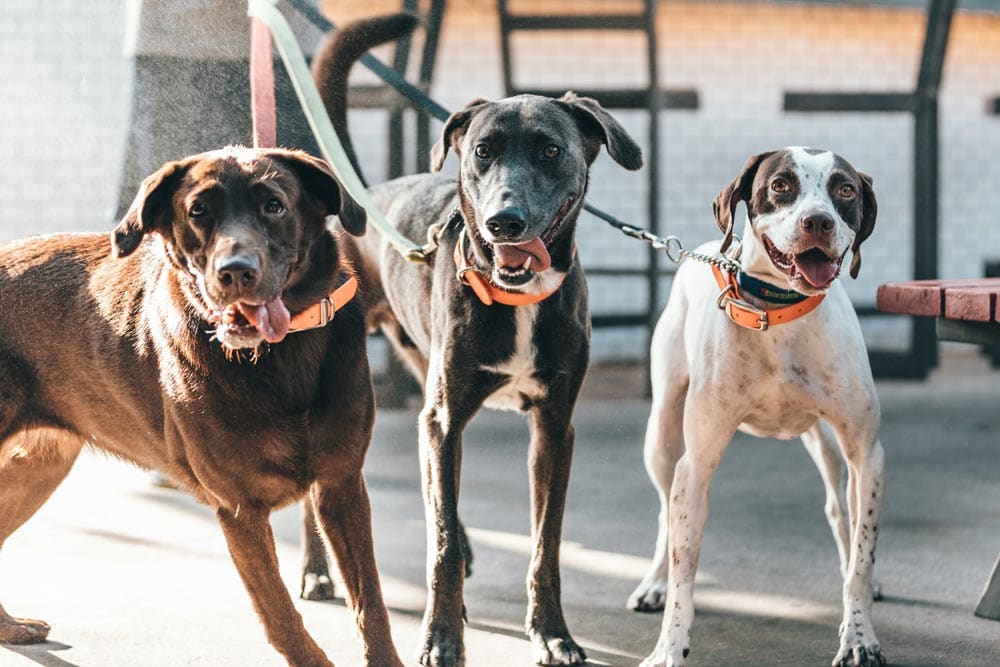
Getting dragged, jolted, and yanked on walks is a nightmare for any dog owner. Aside from being unpleasant and embarrassing, it can also be dangerous for you, your dog, and anyone else you encounter on your walks.
Contrary to popular belief, your dog isn’t being naughty deliberately when they pull on the leash. In fact, most of the time it is simply a case of not knowing any better.
Understanding why your dog pulls, using the right tools, and training your pup with consistency and reward-based methods are all key steps in teaching them to walk politely.
Preventing Your Dog from Pulling on a Leash Before You Even Start Walking
In most cases, unwanted leash pulling is a combination of lack of training, circumstantial triggers, and the wrong equipment. The good news is that it is possible to improve your pup’s leash-walking behaviors, and the following tips will get you started:
1. Use the Right Equipment
Reserve the 10-ft retractable leash for when your pup is more experienced and opt for a flat collar instead. This allows for more control and is much easier to train with.
2. Begin With a Short Leash
It may be tempting to let your dog sniff, run, and investigate as they please, but it’s counterproductive. Freedom on a walk should be a reward, not an expectation.
A short leash helps to keep your pup focused on their human companion and prevents them from getting distracted by things in the environment.

3. Focus on “Focus”
Don’t want your dog getting distracted on walks? Teach them to focus on you. Your dog should understand that they should look to you for direction and guidance and not the other way around.
This part of training should start at home, where there are fewer distractions, and you have more control over your dog’s surroundings. Start by:
This goes beyond just looking at you; it shows your dog that you are the one in charge and that they should rely on your decisions.
4. Establish Boundaries at Every Stage of the Walk
Part of teaching dogs how to control themselves and how to respond to their environment is establishing boundaries. This means teaching your pup what is and isn’t allowed when it comes to leash walking. This includes every single part of the walk, such as:
Consistency is critical here. The more consistent you are, the faster your pup will learn what is expected of them.
5. Use Positive Reinforcement
You want to teach your dog to respect you and leash communication, not to be scared of you. As such, positive reinforcement is key to ensure your pup associates good things with walking on a leash.
Verbal praise and treats are excellent ways to show your pup that you’re happy with their behavior.

The 10 Tips to Stop Dogs From Pulling on a Leash
Once your pup has a handle on the basics, it’s time to start tackling leash pulling.
- One: Wear Them Out Before the Actual Walk: Tire out your pup with a game of fetch or tug before you take them on a walk. This will help to keep them calmer and more focused.
- Two: Keep Training Walks Short: If your pup is still learning, keep their training walks short and sweet. This can mean just walking around your garden before they graduate to walking around the block, and so on.
- Three: Stop When Your Dog Pulls: As soon as your pup pulls, stop in your tracks and stand still. This shows them that the only way to move forward is by walking politely on a loose leash.
- Four: Reward Calm Walking: When your pup is walking on a loose leash, toss them a treat so they associate calm behavior with good rewards.
- Five: Change Directions Frequently: When walking, change directions frequently to keep your pup from becoming too focused on getting to their destination.
- Six: Bring Along Some Distractions: If your dog loves toys, bring one along on your walks. This helps keep their minds engaged and distracted from their surroundings.
- Seven: Practice Regularly: The more you practice, the better your dog will learn! Aim to practice leash walking with your pup at least a few minutes every day.
- Eight: Stay Calm & Patient: Your dog will inevitably make mistakes. Don’t punish them for it – ignore the unwanted behavior and focus on reinforcing the ones you want.
- Nine: Bring in the Pros if Necessary: If your pup is still having trouble after trying all the tips above, consider enlisting a professional dog trainer or behaviorist to help out. Doing so doesn’t mean you’ve failed. It only means your beloved pup needs more assistance from someone with more experience.
- Ten: Keep It Fun: Above all, make sure leash walks are enjoyable for both you and your pup! Treat it as an opportunity to bond, strengthen your communication, and experience the world together.
Why Do Dogs Pull on the Leash?
Understanding your dog’s unwanted behavior is the first step to correcting it. This applies to leash pulling as well. Here are some of the most common reasons why a dog may pull on their leash:
Your Dog Hasn’t Learned to Not Pull
Dogs, especially puppies, don’t inherently know that pulling on their leash is wrong. This includes all the actions related to it, such as wearing a collar, turning, and stopping with their human companion, and keeping the leash slack.
In other words, proper leash walking is a skill that dogs need to learn. Accepting your role as a teacher, and having the patience to start from the basics, will help you build a strong foundation for leash walking.
Your Dog May Be Too Excited
Keep in mind that your dog’s sense of smell, sight, and hearing are exponentially more powerful than ours. This means that your pup can detect a lot more during walkies, leading to an increased level of excitement and stimulation.
Many dogs will react to their environment by pulling on the leash to get closer to what interests them.
Your Dog May be Anxious or Stressed
Another common reason why a dog may be pulling on the leash is anxiety or stress. If your pup pulls hard and fast in a certain direction, it could be a sign that they are trying to distance themselves from what’s causing them distress.
Again, since canine senses are more sensitive than ours, you may not be aware of the triggers that are causing your pup to feel uneasy or uncomfortable.
You’ve Been Rewarding the Pulling Behavior
Dogs are incredibly smart, and it only takes them a short while to link certain behaviors with positive reinforcement. If you’ve ever verbally praised your pup or given them treats when they are pulling on the leash, this could be why they continue to do so.
You’re Not Using the Correct Equipment
The right tools and equipment are essential for teaching your pup how to walk politely, and the wrong ones can easily reinforce negative behavior.
For instance, using a retractable leash with a puppy or a young dog can cause confusion, as it allows your pup to pull and go wherever they please.
Additionally, certain collars like choke chains, prong collars, and electric shock collars are best avoided. Not only are they harsh and inhumane, but research has also found that the use of such equipment can lead to an increase in aggressive behaviors.
Even harnesses can be problematic if not used correctly. Since harnesses redistribute the pressure your pup pulls with, they can actually make leash pulling worse.

Conclusion
Leash manners are more than just teaching dogs not to pull. It’s a two-way process: before you can teach your dog how to walk on a leash, you must first understand their needs and preferences. Only then can you teach them the basics of leash communication: how to move, how to respond to their environment, and how to respect your lead. With patience and consistency, your pup will be a master leash walker in no time. Good luck!
Featured Image Credit: Dmitriev Mikhail, Shutterstock








